Navigation
Install the app
How to install the app on iOS
Follow along with the video below to see how to install our site as a web app on your home screen.
Note: This feature may not be available in some browsers.
More options
You are using an out of date browser. It may not display this or other websites correctly.
You should upgrade or use an alternative browser.
You should upgrade or use an alternative browser.
RODI Flush valve
- Thread starter reefrealtors
- Start date
-
- Tags
- #urgent
- Tagged users None
Its a by pass flush valve for your ro membrane. My air water ice unit has 1.
When you 1st turn it on. Flush the units filters for maybe 2 minutes before turning the knob and making pure rodi.
Just adds life to your ro embrane. you should hear the air or have flow decrease when its on and active.
D
When you 1st turn it on. Flush the units filters for maybe 2 minutes before turning the knob and making pure rodi.
Just adds life to your ro embrane. you should hear the air or have flow decrease when its on and active.
D
Leave it the way it is
I flush mine for at least 20 minutes before I start making RO/DI water. My TDS are super high after not using the unit for several hours or days.Its a by pass flush valve for your ro membrane. My air water ice unit has 1.
When you 1st turn it on. Flush the units filters for maybe 2 minutes before turning the knob and making pure rodi.
Just adds life to your ro embrane. you should hear the air or have flow decrease when its on and active.
D
The tds going into the unit from the supply matters too.
Where i live the tap drinking water is only 32 or so tds.
I dont remember if its ppm or ppt but i can basically get away with a single di resin unit if i wanted and just change the di resin contantly. Would not be cost effective but i could do that.
Lol
D
Where i live the tap drinking water is only 32 or so tds.
I dont remember if its ppm or ppt but i can basically get away with a single di resin unit if i wanted and just change the di resin contantly. Would not be cost effective but i could do that.
Lol
D
rkpetersen
walked the sand with the crustaceans
View BadgesExcellence Award
Reef Squad Emeritus
Pacific Northwest Reefers
When the lever is positioned the way it is in the picture, the flow is restricted, which raises the pressure on the RO membrane, causing production of RO water. When the lever is turned to FLOW, the flow is no longer restricted, dropping pressure so RO water is no longer made, and flushing any built up sediment from the membrane.
Similar threads
- Replies
- 6
- Views
- 222
- Replies
- 5
- Views
- 138
- Replies
- 13
- Views
- 245
















